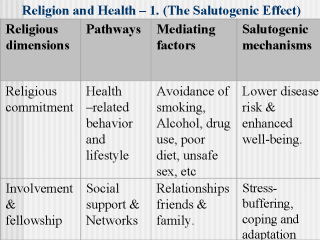| front |1 |2 |3 |4 |5 |6 |7 |8 |9 |10 |11 |12 |13 |14 |15 |16 |17 |18 |19 |20 |21 |22 |23 |24 |25 |26 |review |
 |
Several studies
have shown a positive correlation between religiosity and subjective health. Levin and
Vanderpool (1987) analyzed 28 such studies, and found a consistent, though small,
relationship, with other variables controlled. This correlation as is known, is not an
accurate indication of physical health, however other researches have shown as well a
positive effect of religion on objectively measured health. There have been numerous
studies of the relation between religion and morbidity, and effects have been found for
all the major diseases, including heart disease, strokes, several kinds of cancer, colitis
and enteritis (Levin, 1996). Levin (1996) shows the possibility of the salutogenic link between religion and health. See table on slide for some of his examples: For more examples given by Levin on this see the following website and look for the journal noted under the reference list: References: Levin, J. S. & Vanderpool, H. Y. (1987). Is frequent religious attendance really conducive to better health? Toward an epidemiology of religion. Social Science Medical Journal, Vol 43, No 7, 589-600. As quoted in Beit-Hallahmi, B. & Argyle, M. (1997). The psychology of religious behavior, Belief & Experience. London. Routledge. Levin, J. S. (1996). How religion influences morbidity and health: Reflections on natural history, Salutogenesis and host resistance. Social Science Medical Journal, Vol 43, No 5, 849-864. |
| front |1 |2 |3 |4 |5 |6 |7 |8 |9 |10 |11 |12 |13 |14 |15 |16 |17 |18 |19 |20 |21 |22 |23 |24 |25 |26 |review |